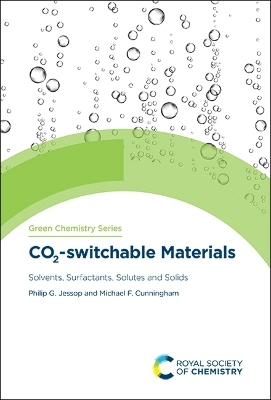
CO2-switchable Materials
Royal Society of Chemistry (Verlag)
978-1-78262-876-7 (ISBN)
CO2-responsive materials are a relatively recent innovation. In general, stimuli-responsive materials exhibit reversible changes in their physical or chemical properties in response to external triggers such as temperature, pH, light, or voltage. However, there are often limitations in applying these triggers including economic and environmental costs, and product contamination. The realization that CO2 can be used as an effective trigger for stimulating changes in material properties has prompted a surge in interest in this area within the past few years, with numerous new studies currently underway in several countries. CO2 is an ideal trigger for switchable or stimuli-responsive materials because it is benign, inexpensive, green, abundant, and does not accumulate in the system. Many different CO2-responsive materials including polymers, latexes, solvents, solutes, gels, surfactants, and catalysts have been prepared.
Summarizing recent progress in the preparation, self-assembly, and functional applications of CO2-responsive materials, this book explores the physical chemistry of CO2-switching, including constraints on structural design and process conditions, together with applications. With emphasis on the environmental, health, and safety advantages and disadvantages compared to conventional materials, it is ideal for researchers and industrialists working in green chemistry, chemical engineering, and polymer chemistry.
Dr Philip Jessop is the Canada Research Chair of Green Chemistry at Queen’s University in Canada and the Technical Director of GreenCentre Canada. His research interests include green solvents and the chemistry of CO2 and H2. Distinctions include the NSERC Polanyi Award (2008), a Killam Research Fellowship (2010), Canadian Green Chemistry & Engineering Award (2012), the Eni Award for New Frontiers for Hydrocarbons (2013) and Fellowship in the Royal Society of Canada and the Royal Society of Chemistry. He serves as Chair of the Editorial Board for the journal Green Chemistry, has chaired two major international conferences and helped create GreenCentre Canada, a centre for the commercialization of green chemistry technologies. Professor Cunningham is a recipient of an Ontario Research Chair in Green Chemistry and Engineering. His research program involves the study of carbon dioxide switchable polymers, polymer colloids, living radical polymerisation and the modification of natural polymers. His awards include the Syncrude Canada Innovation Award, presented by Canadian Society for Chemical Engineering (awarded for distinguished contribution in the field of chemical engineering before the age of 40) and the Canadian Green Chemistry and Engineering Award. He is a Fellow of the Chemical Institute of Canada. He serves on the technical advisory board of GreenCentre Canada, whose mandate is to commercialize emerging green chemistry innovations originating from academic research.
Introduction to Switchable Materials;
The Chemistry of CO2-Triggered Switchable Materials;
CO2-Switchable Organic Solvents;
CO2-Switchable Aqueous Solutions;
CO2-Switchable Surfactants;
CO2-Switchable Particles;
CO2-Switchable Surfaces and Coatings;
CO2-Switchable Gels and Adhesives;
CO2-Switchable Catalysts and Other Solutes;
Analysis and Future Outlook
| Erscheinungsdatum | 08.01.2019 |
|---|---|
| Reihe/Serie | Green Chemistry Series ; Volume 67 |
| Verlagsort | Cambridge |
| Sprache | englisch |
| Maße | 156 x 234 mm |
| Gewicht | 554 g |
| Themenwelt | Naturwissenschaften ► Biologie ► Ökologie / Naturschutz |
| Naturwissenschaften ► Chemie ► Organische Chemie | |
| Naturwissenschaften ► Chemie ► Physikalische Chemie | |
| Technik ► Maschinenbau | |
| ISBN-10 | 1-78262-876-2 / 1782628762 |
| ISBN-13 | 978-1-78262-876-7 / 9781782628767 |
| Zustand | Neuware |
| Haben Sie eine Frage zum Produkt? |
aus dem Bereich


